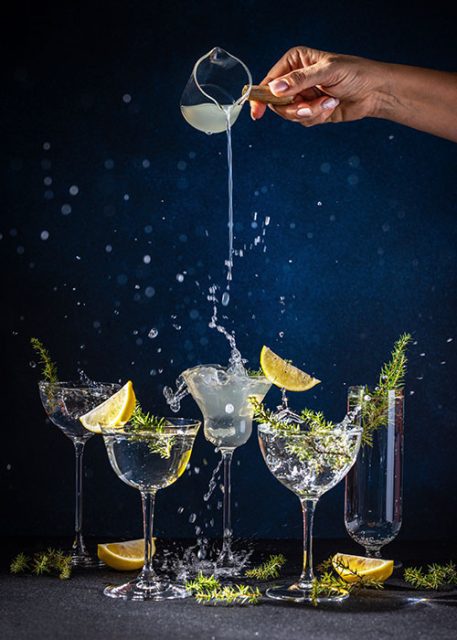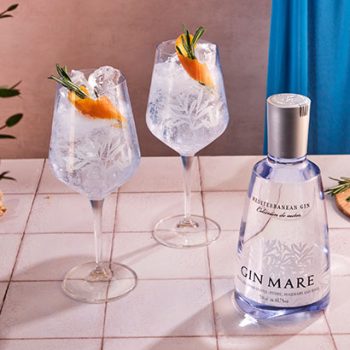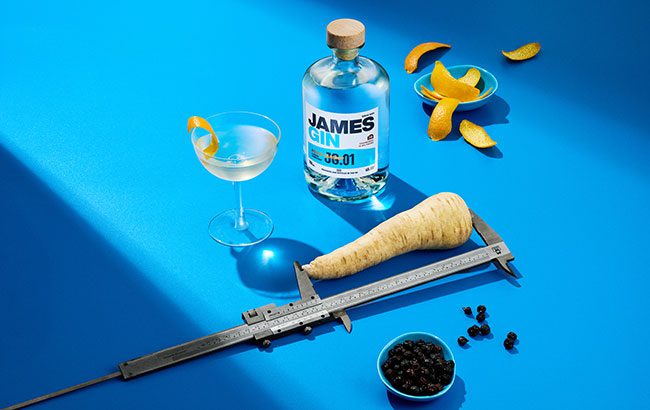What’s really going on in the gin category?
By Claire DoddWith the waning of the gin boom, producers are looking to fresh ideas and under-served markets to promote their brands.

*This feature was originally published in the July 2025 issue of The Spirits Business magazine.
“It’s absolutely a good time to be a gin brand – if you’re focused, innovative and committed to adding real value,” says Alex Watson, co-founder of Renais Gin. “We’re ambitious, and we believe there’s huge runway ahead.”
It has been an eventful decade for gin: from heady growth and its place as the firm darling of the spirits category, to discussion of its oversaturation and accelerated demise.
While recent commentary has been dominated by doom and declines, how is gin doing really? And what’s next?
IWSR data states that volumes rose globally by 2% year on year in 2023-24 (down from the 4% increase seen in 2023), though value was flat. Not too bad, given the context.
It predicts volumes will grow by just 1% from 2024 to 2029, which is better than a decline. Flavoured gin – which accounts for 10% of the global gin market – is forecast to grow by 2%. But it’s a far cry from gin’s days of double-digit growth, when, according to IWSR data, consumption worldwide soared by 36% between 2015 and 2019.
Economic pressures
Emily Neill, IWSR chief operating officer of research, says: “The gin boom is fading, with the category experiencing declines driven by economic pressures and a challenging on-trade environment.
“There were bright spots, however. Asia retained the highest growth in absolute volume. In the Philippines, the number one gin market globally, the category thrived, boosted by the transition of local brandy consumers to local gin due to its affordability, and strong brand loyalty to local gins. Gin also experienced strong year-on-year volume growth from a small base in China (up by 20%) and Thailand (up by 6%).”
Meanwhile, speaking at June’s Ginposium conference in London – The Gin Guild’s education day for the industry – Chris Pitcher, drinks analyst at Redburn Atlantic was somewhat cheerier. Citing IWSR data, Pitcher noted that worldwide gin consumption reached approximately 107 million nine-litre cases in 2024, 25% ahead of 2019 levels.
Excluding the lower price bracket, gin also became the fourth-biggest category in premium-plus international spirits last year, overtaking vodka. Key to its resilience is its place as a relatively international category, not only reliant on a few key markets. Yet key markets – namely the US, the UK, Spain and Germany – are slowing. Nielsen data for the off-trade showed that UK gin volumes were flat in the 52 weeks to 20 April 2025, which Pitcher called “good news” after periods of decline. The gin sector lost seven percentage points of UK spirits volume share between 2020 and 2024, while most other categories gained. “The problem is, I don’t see it improving again,” says Spiros Malandrakis, head of research – alcoholic drinks at Euromonitor International. “Spirits are cyclical. Drinkers tend to not drink whatever their parents used to do. And sometimes they gravitate back to what their grandparents used to be doing, or find their own. Gin has reached that level of maturity, saturation and ubiquity.”
Global English-style gins lost 0.8% in volume for 2024, according to Euromonitor data. It’s a further deterioration compared with 2023, which saw a 0.3% decline, and a far cry from 2022’s 6% growth, something Malandrakis chalks down to post-pandemic enthusiasm.
“Insane amounts of innovation” and over-experimentation with flavour has confused consumers, adds Malandrakis. “These are all the cardinal sins of the later stages of maturity that start leading to this kind of long-term structural decline. We’re not there yet, but I think I start hearing some of these alarm bells.”
But not everyone shares that fear. Speaking at the Ginposium conference, Michael Vachon, drinks advisor and co-founder of Maverick Drinks, acknowledged: “It’s important not to gloss over the challenges the industry is facing.” But he said the industry should “shout to anyone who’ll listen, gin’s demise is overblown and if anything… it’s a great time to be gin.”
Elena Petrov, global brand director for Gin Mare at Brown-Forman, says: “From our perspective, what’s happening is that the gin category is evolving. While the category has faced headwinds in some mature markets, it remains a significant global player, and within that, super-premium brands like Gin Mare are showing resilience and growth.”
Long-term growth

Gin Mare’s organic sales grew by 1% in the year ending 30 April 2025, led by Spain, Germany and France, which were offset by a decline in Italy due to a distribution change. But Brown-Forman CEO Lawson Whiting bets Gin Mare will contribute long-term growth for the firm. “Looking ahead, we see significant opportunities in two key areas: premiumisation, particularly in emerging markets, and travel retail, along with culinary and experiential storytelling that aligns with evolving food culture and lifestyle trends,” adds Petrov. “Gin is far from over; it’s entering a more refined, more intentional chapter, and we’re excited to help shape what comes next.”
Nitesh Chhapru, Diageo’s global brand director – Tanqueray and the super-premium gin portfolio, agrees about the growth opportunities. He says: “In Europe, volume declined ahead of value, suggesting the continuation of a premiumisation trend. There is clear potential to leverage growth in expansion markets: ones where gin is a relatively new category, and where consumers are excited about the versatility, freshness and sophistication that gin offers.” Citing IWSR gin value data for 2024, Chhapru said markets like China and India are rising by double digits, up 13% and 11% respectively. In China, growth was led by global gin brands, while local craft brands boosted India.
But like Malandrakis, he acknowledges that flavoured gin has fizzled, noting global declines, while traditional expressions have had marginal growth. “Flavour-driven consumers are more likely to be trend-led, and flavoured gin does not always deliver the excitement consumers are looking for anymore,” he adds.
Jon Hillgren, co-founder of Swedish brand Hernö Gin, predicts a return to dry gins and traditional styles. Frustrated with the over-marketing of some brands, last year it launched its “noise cancelling” Hernö Botanical gin, made with just juniper berries and coriander seeds. Hillgren notes production costs pressures have reduced its margins by over 10% in recent years.
“There’s a lot of gin brands out there… marketing themselves as the smallest distillery in the world, or the largest, or the youngest, or they have been to the moon, or whatever,” says Hillgren. “We want the gin to talk, not the storytelling around it. Hopefully, we’re going back to core gins.”
So when it comes to London Dry, or traditional-style gins, is it time to make gin, well, chic again? Jaime Keller, brand director of Bombay Sapphire at Bacardi, says the brand has been putting in the work. “We’re seeing an uptick in first-time trial, as well as in more emotive indicators, like being recognised for making great-tasting drinks,” he says. “To build on this momentum, we’re focused on connecting with the next generation of culturally attuned consumers.”
Partnering with film director Baz Luhrmann and fashion designer Stella McCartney for their Met Gala after-parties, it put the brand and its new champion serve Bombay Sapphire Sparkling Lemon (gin, fresh lemonade and sparkling water) in the hands of “some of the buzziest names in fashion”.
Other activity includes its ‘Step Into The Blue’ campaign, focusing on its distinctive bottle, and becoming the official gin partner of the UIM E1 World Championship—the world’s first all-electric powerboat racing series. Keller paints a picture of an American market still in its infancy, and a need to divert from the gin and tonic serve.

“From research we conducted last January, we learned that many US consumers still aren’t sure how to consume gin. The category as a whole has struggled with relevance,” she adds. “One of the biggest barriers we uncovered was around taste perception. That has really shaped our new approach of going big with the Bombay Sapphire Sparkling Lemon cocktail.
“We are reintroducing gin via a cocktail serve that is more accessible, interesting, and sessionable, perfectly complementing evolving consumer preferences.”
Attaching your brand to trending cocktails is always a good idea. London-based Hayman’s recently created a video to show consumers and bars how easy and convenient it is to make a pre-batched Freezer Martini using its gin. And given the momentum behind the Martini, it’s perhaps surprising more brands aren’t following suit.
But what about the new wave of gins? Do brands launched after the boom offer some insight into what a gin brand needs to survive and thrive after the ‘ginaissance’?
Renais – launched by Alex Watson and his sister, Harry Potter star Emma Watson, and distilled from French wine grapes – just celebrated its second birthday, with the launch of a gin rested for one year in Grand Cru wine casks. “In that time, we’ve more than tripled our volume year over year,” adds Alex Watson. “Compared with the broader category, which is still finding its post-pandemic footing, we are probably a bit of an outlier. To stand out today, you can’t just make good gin – you have to create something distinctive, meaningful and multidimensional. Now it’s about depth and clarity of purpose. For Renais, that meant carving out a unique proposition: a terroir-driven, grape-distilled, sustainable luxury gin from a second-generation wine-making family. It’s a clear point of difference.”
A growing need for premium and ultra-premium products, traditional styles, genuine stories and provenance are increasingly vital. But so are outliers that surprise, intrigue, and pull in new drinkers.
“We’re not really fussed what state the wider category or market is in (or is said to be in),” says Vishal Patel, the new CEO of James Gin, which was launched by former Top Gear presenter James May.

Gin for the locals
The launch in 2021 was not conceived with “any eye for an opportunity”, adds Patel. “James’s local pub in Wiltshire was going to close, and so against everyone’s advice, he decided to buy half of it (because living in the countryside would otherwise be pointless). His next thought was that it would be fun to make some gin for the locals.
“Having been dissuaded from doing this in his shed at home, he teamed up with local master distiller, Hugh Anderson, to create a gin that blended the flavour of parsnip (because it reminded him of the dampness of England) with Asian spices (because they added excitement).
“All our gins are savoury, (based on parsnips, beetroot, mushrooms, gherkins, and mustard so far) not because we predicted a trend but because we like the flavours. We don’t really talk about ‘flavour profiles’, hand-plucked botanicals or wearisome back stories invented by ad agencies – because we think our customers are bored of that kind of old-fashioned marketing bullshit. Many brands don’t seem to have noticed this yet.”
The brand’s first 1,000 litres sold out in 48 hours, while its customer base skews young, with 25- to 34-year-olds accounting for 30% of sales, then 35- to 44-year-olds at 25%. In 2024 it passed US$2 million in revenue, with over US$1m coming from the US, which Patel says, despite the turbulence, is “experiencing the start of the same gin boom the UK experienced with the launch of Sipsmith in 2009” with 10% growth of US$30-plus gins forecast from 2023-28, according to IWSR data. “The emerging trend for younger gin drinkers, particularly in the US, is driven by their love of cocktails,” he adds.
“In the UK, the favourite way to drink our gin remains the good old G&T – which is fine – but it’s hardly an imaginative way of exploring the potential of gin.
“Our mission is therefore bilateral – to educate Americans in the joys of the savoury G&T, and to show the Brits that a cocktail can be more than the common Martini (and that whether it’s shaken or stirred is neither here nor there).”
Industry insights
How do you see the gin market evolving over the next three to five years?
Fergus Woodward – managing director, Peddlers Gin
“Globally there has been a contraction in gin brands over the past few years. I think the way to win is by having authentic and compelling points of view. Chinese spirits, and Asian spirits in general, are often a bit of a bright spot in that landscape, not least because we’re starting from such a small base. As a Shanghai company, the domestic picture looks a little different, and we’re very positive for the next five years. The alcohol-consuming demographic is shifting younger, away from business occasions and more to social settings. On the back of this, cocktail culture continues to pick up steam in China, driving white-spirits consumption – there were about 60,000 recorded bars open in China in 2024. According to IWSR, while gin in general is forecast for a 5% compound annual growth rate (CAGR) drop over the next few years, the locally made gin category is forecast to rise significantly higher (more like 20% CAGR).”
Danielle Leavell – founder, CEO and master distiller, Astraea Gin
“We expect the gin market to evolve through premiumisation, sustainability, and a renewed focus on authenticity, with a bold, innovative edge. Consumers are shifting away from flavoured gins in favour of more refined, terroir-driven expressions that capture regional identity and seasonal nuance. Sustainability will be at the forefront, with transparency, local sourcing, and eco-conscious practices driving brand innovation. The ultra-premium category will continue to expand as drinkers embrace a ‘less but better’ mindset. At the same time, low- and no-alcohol offerings will grow, aligning with demand for mindful, flavour-forward experiences.”
What growth opportunities do you see for your gin and the category in the year ahead?
David Palacios Jaramillo – global PR manager, emerging brands, Brown-Forman
“In the year ahead, we see several exciting growth opportunities for both Gin Mare and the super-premium gin category. First, travel retail continues to rebound strongly, and it’s a key channel for us, not just for sales, but for brand discovery and storytelling. We’re investing in immersive experiences that bring our Mediterranean roots to life in that space.
“Second, emerging markets are showing a strong appetite for premium spirits. We’re seeing momentum in places like the UAE and parts of Asia, where consumers are increasingly drawn to brands with authenticity and a strong sense of place. Third, we’re leaning into culinary and lifestyle partnerships. Gin Mare’s flavour profile makes it uniquely suited to food pairing and mixology, and we’re exploring collaborations that tap into the growing intersection of spirits, gastronomy, and culture.”
Related news
